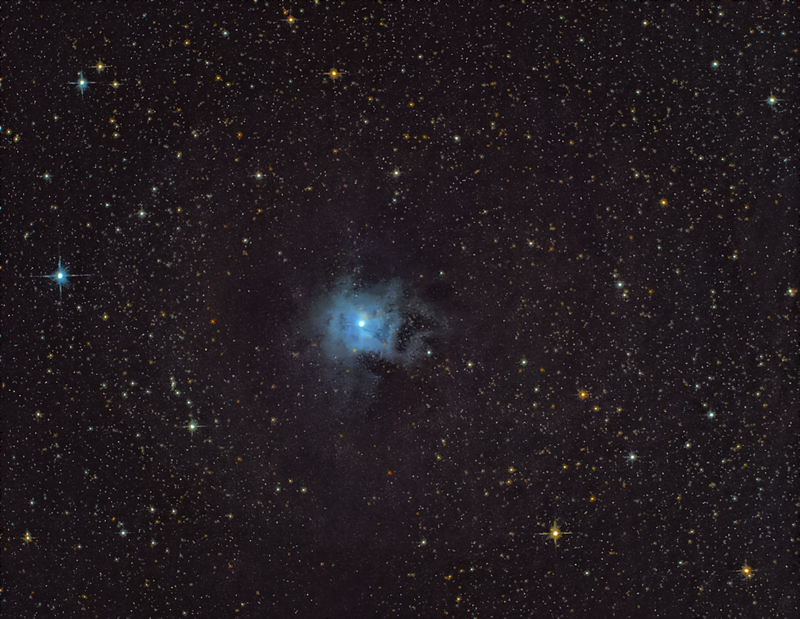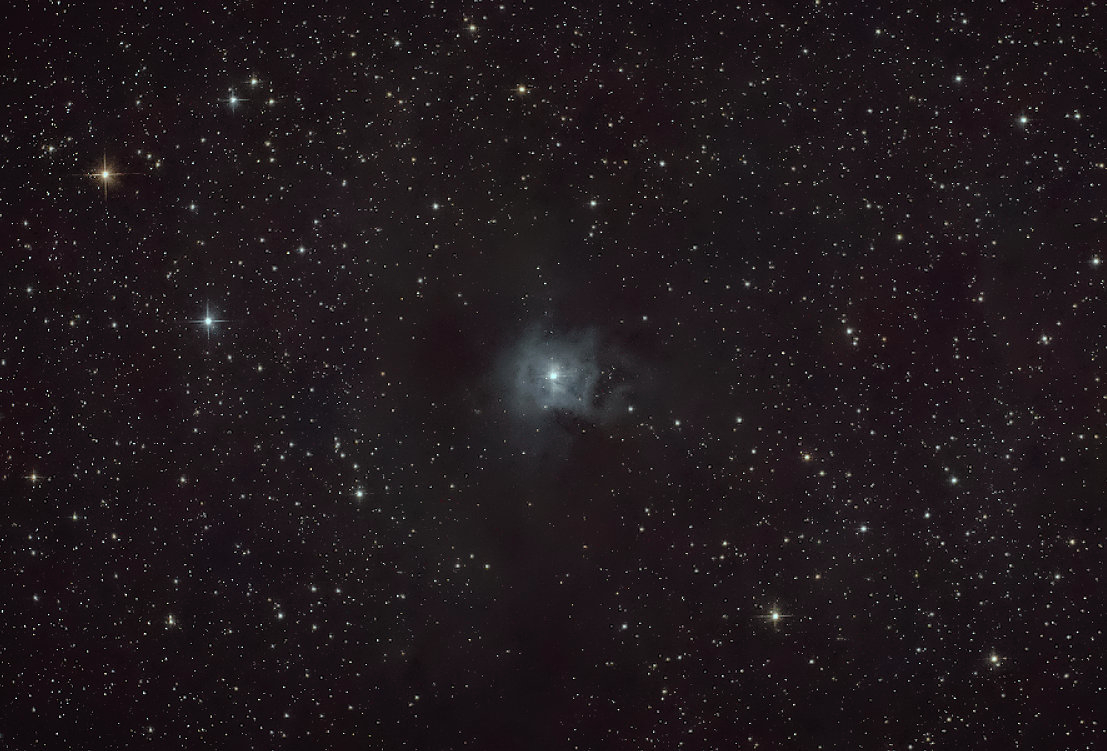-
Posts
95 -
Joined
-
Last visited
Content Type
Profiles
Forums
Gallery
Events
Blogs
Posts posted by JoshHopk
-
-
Another Rosette

Didn't have as long as I would of liked thanks to the clouds, (seems to be a recurring event nowadays!), needs more data to get rid of that noise. Only PNGs so not Hubble quality

I tried out StarNet++ for the starless image; it seems to struggle with the diffraction spikes a bit, but I quite like the result.Imaging - SW130PDS, Stock Canon EOS 100D. 40x 3mins @ISO400 (2hrs)
Guiding - SW 9x50 Finder, ASI224MC
Mount - HEQ5 Pro (Rowan Mod)
Other - SW 0.9x CC
Stacked in DSS and processed in Photoshop-
 6
6
-
-
Might be helpful if you could upload the image in question so we can have a better look. As others have suggested it might be to do with focus, exposure, trailing etc.
Josh

-
Hi Chris,
To calculate focal length with a reducer, you simply multiply the native focal length by the reduction factor. For your 600mm with a .85 reducer, the new focal length would be 510mm (600*0.85) and for you 715mm and .79 reducer, ~565mm (715*0.79).
Hope this helps,
Josh
-
Hi Graham,
It looks like an lens flare to me; probably caused by scattered light coming from the bright moon. I'm not certain though, I'm sure others will share their insights.
Josh

-
-
Hi there,
There's a popular control system for equatorial mounts called EQMOD. This software is full of useful tools, including a 'Mosaic GoTo' mode. This will be perfect for wide field shots of large nebulae, the moon and the milky way. There's a great many guides on EQMOD, both on their website and here on SGL, that will give you info on how to use the software and its tools.
Here's the link for more info: http://eq-mod.sourceforge.net/mosindex.html
HTH, Josh

-
Hi there,
Because DSOs are very dim, you need to use long exposures to bring them out in images. You will be limited to very short exposures on a tripod, as it doesn’t track the constantly moving sky. This will cause your image to be blurred; at low focal lengths however this is not so apparent.
Something like the Sky-Watcher Star Adventurer would allow you to take much longer exposures.With your current set up, and perhaps a light pollution filter, you may be able to do some wide field images of the Milky Way, but not much else. You can also download a planetarium software, such as Stelllarium, and this will show you what deep sky objects are visible and where they are located in the sky.
HTH, Josh

-
 1
1
-
-
11 minutes ago, alacant said:
Hi
Not sure what ISO you used but the 100d works best at 400. Maybe keep the exposures the same but at ISO400?
To see an improvement, keep taking frames until you just can't bear it any longer!
Cheers
Ah, I was shooting at 1600. Thanks for the info, I’ll use 400 next time.
Thanks, Josh -
-
14 minutes ago, alacant said:
Hi
Lovely shot.
You probably could get similar results with photoshop, but it's going to take hours of trial and error to get close.
Have a go with the StarTools denoise Non-linear Response. Each shot is different in it's requirements but the final denoise is usually the icing on the cake.
I had a go with the png but there's not much colour information in it. Then again, I'm hopeless with colour. Post -a link to- the stack if you like. HTH.
Wow! That's cleaned it up to no end. Thanks for the advice, I'd tried denoise but I think I may of chosen the other option.
Here's the link to the stack, I forgot to take flats so there may be some gradients: https://www.dropbox.com/s/vd8gfkszyhsocj8/NGC7023_32bit_tif.TIF?dl=0
Thanks again, Josh
-
33 minutes ago, Simon Dunsmore said:
Hi Josh, Great shot. I just received my 130pds two weeks ago and I'm really looking forward to First light.
Sounds like I have very similar kit to you. I see that you're using the SWCC, how have you found this.
Thanks for the inspiration!
Simon
Thanks Simon,
The SWCC is all in all a great corrector, it eliminates coma right to the corners. However it does act as a 0.9x reducer, which means that I have to rack in the focuser quite a long way, causing the tube to take a bite out of the stars. This really isn't a major issue and it can be easily fixed with a hacksaw, or by moving the primary up the tube. I like the 0.9x reduction as it puts the scope to 585mm at f/4.5. Some people say that it suffers with some internal reflections on bright stars (Alnitak for example), but I'm yet to find this problem as I rarely image targets containing such stars.
Enjoy your new gear
Josh
-
 1
1
-
-
Hi all,
I received my 130PDS about a week ago as my first AP scope, and have spent the last few days getting it all set up and balanced. Last night was first light, and I decided to go for the Iris Nebula as it was high up and its size is a good fit for the 130 and my Canon DSLR. I used the StarTools free trial to process it (Hence the low resolution) as i just couldn't seem to get any decent results with Photoshop
 , (any ideas?).
, (any ideas?).
Canon EOS 100D (Stock), HEQ5 Pro, 130PDS, 0.9x SWCC, 9x50 finder and ASI224
28x 3min Guided Exposures (1hr 24min Total Integrated Exposure)
Criticism and comments welcome!
Thanks, Josh

-
 5
5
-
-
Hi there,
You'll need a Canon T-Ring as you say, and also a suitable T-Adaptor; these screw into the T-Ring and then either thread onto the focuser or simply sit inside the focuser.
-
How were you aligning? If it was just through the polarscope on your mount, remember that the reticle rotates with the R.A axis, so Polaris would have appeared to have moved if the R.A axis was not in the same place as it was initially.
-
1 hour ago, uhb1966 said:
For astro stuff, you should generally opt for a powered one as many astro gear takes its power from the hub. If the drain on the master's power hub gets above 500mA, the master usually shuts down the usb port.
1 hour ago, uhb1966 said:For astro stuff, you should generally opt for a powered one as many astro gear takes its power from the hub. If the drain on the master's power hub gets above 500mA, the master usually shuts down the usb port.
Thanks everyone for the responses, I’ll go for a powered hub and run it off my power tank.
-
6 minutes ago, Wyvernp said:
I integrated it into my homemade powerbox.
12v goes into the powerbox then I use
a dc-dc adaptor to step down the voltage https://www.ebay.co.uk/itm/DC-DC-Converter-Regulator-12V-Stepdown-to-5V-3A-15W-Car-Power-Supply-Module-UK/142407861263?ssPageName=STRK%3AMEBIDX%3AIT&_trksid=p2057872.m2749.l2649
which plugs into the back of the usb hub.
Thanks for the explanation, seems pretty straightforward. I’ll probably give this a go

-
21 minutes ago, Wyvernp said:
I cheaped out on my USB hub and bought this https://www.amazon.co.uk/dp/B01DWEQGIK/ref=cm_sw_em_r_mt_dp_U_PH56Eb06JA5EJ although I had to power it for it to work properly. Probably wouldn't recommend one as I may have just gotten lucky with mine but I run both cameras and mount through it with no issues.
Thanks for the reply, that hub looks good; how did you power it?
-
Hi all,
I’ve just got all of my new gear for my first AP rig, but with the addition of a guiding setup, I’ve ran out of USB ports on my laptop.
Because of this, I’m looking for a USB hub that I can use in the field. My understanding is that a powered one is more reliable and is a better choice than an unpowered hub.
I know that the Startech one is highly regarded, but I don’t think I can warrant spending £50 on a USB hub. I was wondering if this one might work? If not I may end up going for the Startech one.
Thanks in advance,
Josh
-
23 minutes ago, Anthony1979 said:
Nah just got me thinking have i gone wrong somewhere with my setup.... Its took me nearly a year to get this far.... Wasnt being sarcastic lol
Setup sounds great to me

The folks here are just saying that the Evoguide (whilst a superb guidescope) is overkill for the 130PDS.
Most use the Sky-Watcher 9x50 finder as a guiding scope, (or other 50mm finders), which are cheaper that the Evoguide, and will still be just as good.The only thing you'll likely want to look at adding is a coma corrector, as others have mentioned, such as the Baader MPCC or the Sky-Watcher CC, but you can certainly image without one.
Hope you enjoy your rig, (I've just ordered myself a 130PDS and a guiding setup), I'm positive you'll be able to take some great images with it

-
 1
1
-
-
1 hour ago, alacant said:
Good choice.
You'll need to cut a length from the end of the focus tube if you want round stars. But try it first. It could be you'll not notice;)
HTH
I’ll try putting off assaulting my new scope for as long as I can, but I’m sure I’ll get to it

-
Think I’ve decided for myself

Im going for the SW 0.9x as it’s nowhere near as fussy as the Baader and the reflections it produces are easily fixed in post processing.
-
Hi all,
I know there's a lot of these threads going around, but I thought I should start a new one instead of trying to revive an old one.
I'm going to get a 130PDS soon and I'm aware I'm going to need a coma corrector. I will be using my Canon 100D (APS-C). I think I'd be right in saying the SW 0.9x will need me to move the primary up or cut the focus tube, but has some reflection problems on bright stars, so would I be better of going for the Baader MPCC?
However, some have said that the Baader is fussy about spacing, so how would i go about altering this?
Thanks in advance, Josh
-
After StarSense is calibrated and has finished its alignment process, you can then GOTO anything you like, the mount will know where it is without you having to move it to its HOME position

-
I use this power supply for my HEQ5, I think it would work with the NexStar mount.
I’ve used Celestron’s 7ah power tank with my NexStar mount and it works a treat

-
 1
1
-
















Imaging with the 130pds
in Getting Started With Imaging
Posted
Thanks! Appreciate it